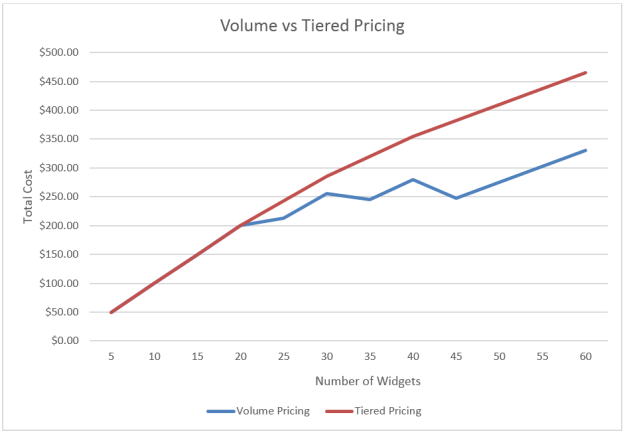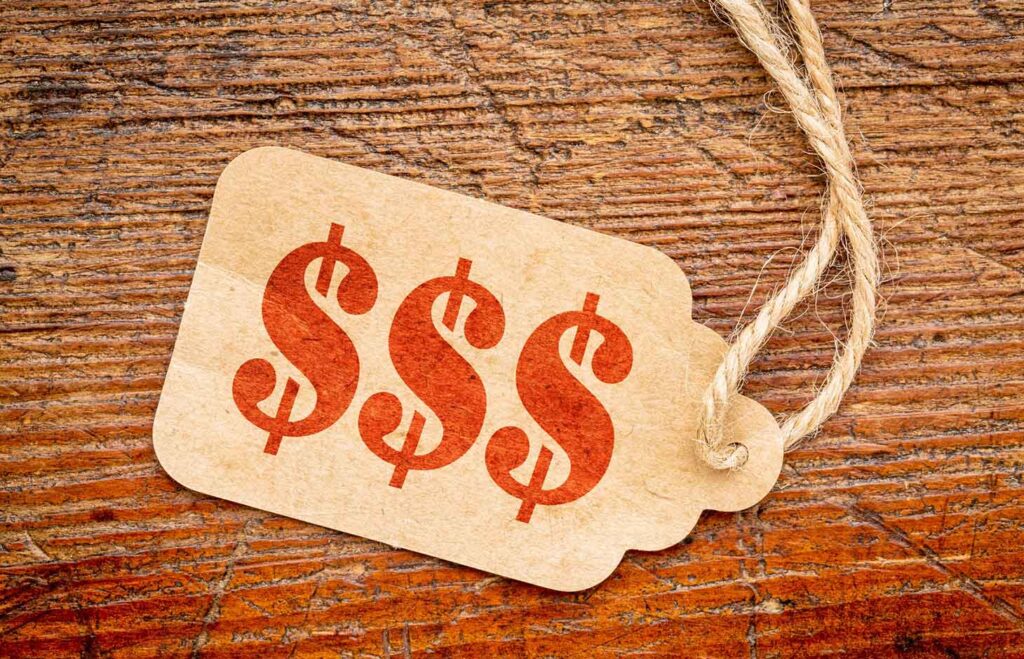“The start of the cloud era was also the launch of subscription plan pricing. At its inception, subscriptions became the standardized method of pricing various software services,” explains SaaS executive and advisor, David Wise.
However, he also notes that the pricing model is shifting in the SaaS world and that the key to future success will be implementing some element of usage-based billing.
“SaaS companies implementing usage-based pricing strategies continue to outperform others in customer success measurements,” Wise says.
There are plenty of different ways your subscription business can implement usage-based pricing. Today, we’ll be diving into tiered pricing/volume pricing: two similar yet distinct forms of metered billing you may consider leveraging for your product.
What is the difference between tiered and volume pricing?
A good place to start is to answer the question, “what is tiered pricing?”.
It’s not uncommon to hear the two terms used as synonyms by the uninitiated. But you? You’re well on your way to becoming a true pricing savant, so let’s get into the nitty-gritty.
Tiered pricing defines a price PER unit within a range.
In this pricing model, there are often multiple tiers or ranges. When a customer purchases a certain number of units that fall within a specific range, pricing is discounted accordingly. And as the number of units purchased increases and moves into higher ranges, discounting increases, and customers end up paying less per unit.
Volume pricing defines a price for ALL units within the range.
In the volume pricing model, there are still various ranges or levels of pricing as there are with tiered pricing. And in both cases, the general idea is to encourage larger orders. However, each unit in this pricing model is assigned the same pricing based on the volume level reached by the purchase.
Still confused? The difference is simple. With a tiered pricing model, your customer pays the price per unit in every range their purchase rises through. But in a volume pricing model, your customer pays the same pricing per unit for their entire purchase.
Real-world examples of tiered pricing vs. volume pricing
It’s easier to see how it works using an example. Let’s say you’re a company that sells SaaS-style licenses for website widgets. You’ve just sold 60 widgets to a customer.
| Volume Pricing | Tiered Pricing |
|---|---|
| 01-20 = $10 per widget 21-30 = $8.5 per widget 31-40 = $7 per widget 41+ = $5.5 per widget | 01-20 = $10 per widget 21-30 = $8.5 per widget 31-40 = $7 per widget 41+ = $5.5 per widget |
| Cost Breakdown: You have sold 60 widgets. This is in the range of 41+; all widgets will cost $5.5 each. | Cost Breakdown: You have sold 60 widgets. First 20 widgets cost $10 each. Next 10 widgets cost $8.5 each. Next 10 widgets cost $7 each. Additional widgets cost $5.5 each. |
The following graph makes it even easier to visualize our example of 60 widgets purchased using a volume pricing model versus a tiered pricing model. As you can see, while these two models seem very similar at first, at around 20 widgets purchased it becomes a much better deal for the customer paying on a volume model.

Tiered pricing calculation
Total cost = (20 x 10) + (10 x 8.5) + (10 x 7) + (20x 5.5) = $465
Volume pricing calculation
Total cost = 60 x 5.5 = $330
Tiered pricing: the results
With tiered pricing, once you fill up a ‘tier’—in this case, the first 20 widgets—you move to the next tier and start charging a different price. The first 20 widgets will cost $10 each. Once you’ve sold 20 from tier one, the next tier costs $8.50 each, the next tier $7, and so on.
Volume pricing: the results
Volume pricing means that, as soon as you hit a particular number, all units will cost the lower price, not just those over a particular threshold. If someone only buys 20 widgets, each widget will cost $10. Once they purchase over 20 widgets, the price of all the widgets in their purchase drops to $9 each; then to $8.
Which metered pricing model is best for your business?
Much as I wish I could give you a straightforward, objective winner, the real answer is—it depends.
A tiered pricing model may increase the appeal of your product because you’re offering different pricing versions for your product. Your prospects will pay up to what they can afford. So, lower-priced plans can draw customers who may eventually move to higher-priced packages.
Tiered pricing also allows for creative options such as grouping products by quality, quantity, service, etc.
A volume pricing strategy, on the other hand, gives your customers the benefit of a bulk discount while allowing you to maintain or increase your sales or profit margin.
The best pricing strategy for your business comes down to knowing your product and your ideal customer profile. Will your ideal customer appreciate a bulk discount? Will your ideal customer realistically buy your product in bulk?
Are you having recurring billing and pricing challenges?
Adaptive recurring billing software can help you reduce errors and simplify your billing and invoicing with flexible catalog capabilities, real-time analytics, and automated subscription and customer management.
It also gives you the ability to offer customers just about any subscription pricing model under the sun—and run pricing experiments to see what works best.
Pricing is one of the main drivers of your business’s revenue. Equipping yourself with the right tools to conquer pricing is a huge step toward maximizing that monthly recurring revenue.
Quick FAQs about Tiered Pricing vs Volume Pricing
Q: What is the key difference between tiered pricing and volume pricing?
Tiered pricing defines a price per unit within a range, meaning customers pay different prices per unit as their purchase rises through the tiers. Volume pricing defines a price for all units within the range, where customers pay the same price per unit for their entire purchase, based on the volume level reached.
Q: How can tiered pricing benefit a subscription-based business?
Tiered pricing can increase the appeal of a product as it offers different pricing options suitable for various customer budgets. Lower-priced plans can attract customers who may eventually move to higher-priced packages. Additionally, tiered pricing enables creative options such as grouping products by quality, quantity, service, etc.
Q: What are the advantages of volume pricing for a subscription-based business?
Volume pricing provides customers with the benefit of a bulk discount, incentivizing larger orders while allowing the business to maintain or increase its sales or profit margin. This pricing strategy is particularly effective if the ideal customers are likely to purchase in bulk.
Q: How do subscription businesses decide between tiered and volume pricing models?
The best pricing strategy for a subscription-based business depends on their product and ideal customer profile. Businesses should consider factors such as whether their customers will appreciate bulk discounts or if they are likely to buy products in bulk. Running pricing experiments using adaptive recurring billing software can help businesses find the most suitable pricing model.
Q: How can adaptive recurring billing software help subscription-based businesses?
Adaptive recurring billing software can simplify a subscription-based business’s billing and invoicing processes, reduce errors, and offer flexibility through features like catalog capabilities, real-time analytics, and automated subscription and customer management. This software also allows businesses to offer various subscription pricing models and run pricing experiments for optimization.
Q: What is the role of pricing in the recurring revenue of a subscription-based business?
Pricing is one of the main drivers of a subscription-based business’s recurring revenue. Implementing the right pricing strategy, using the proper tools and adjustments, can considerably affect a business’s monthly recurring revenue. Appropriate pricing models should cater to customers’ needs and preferences while ensuring that the business achieves its financial objectives.








